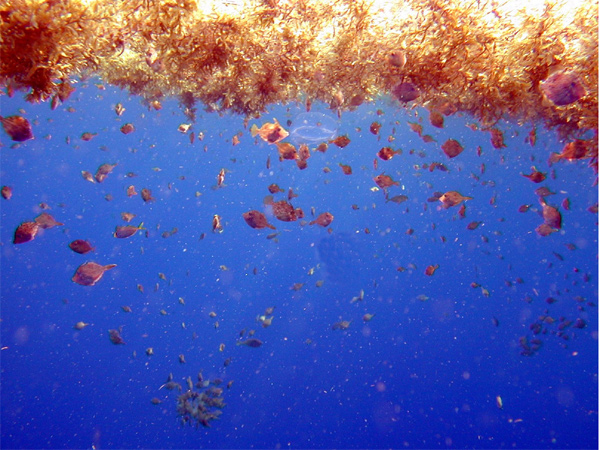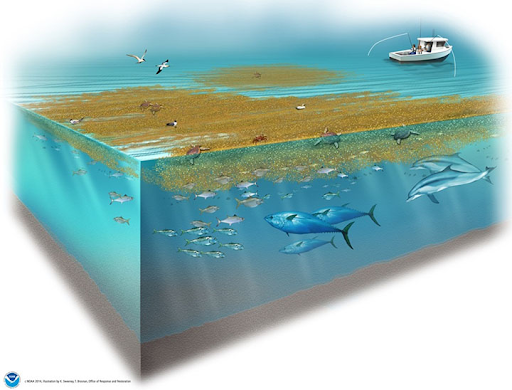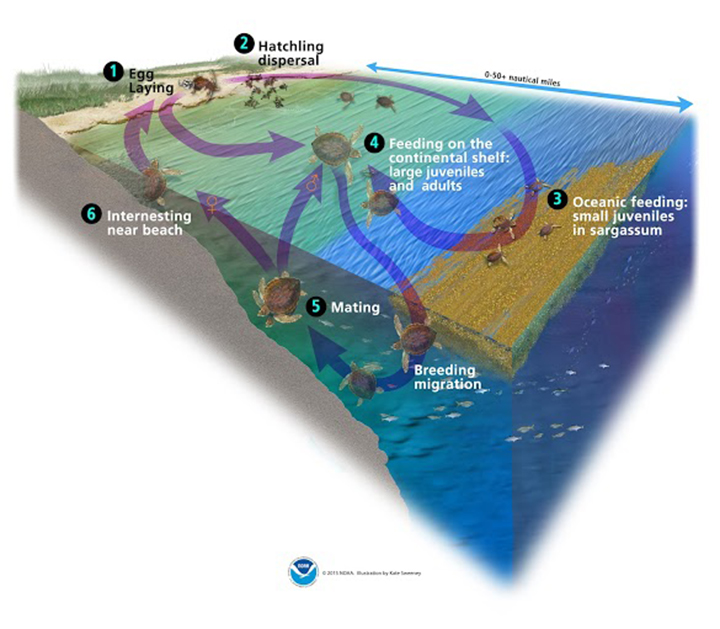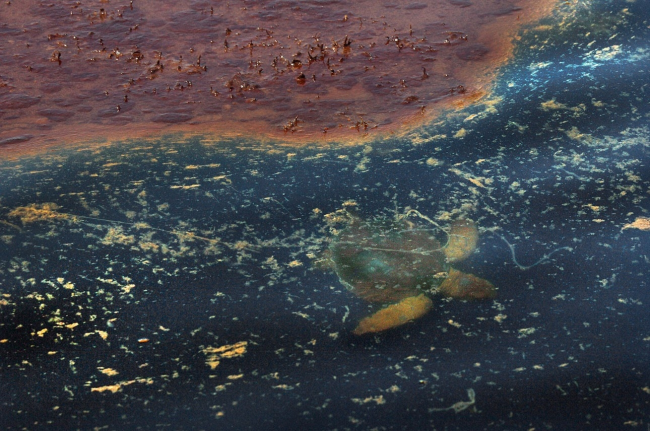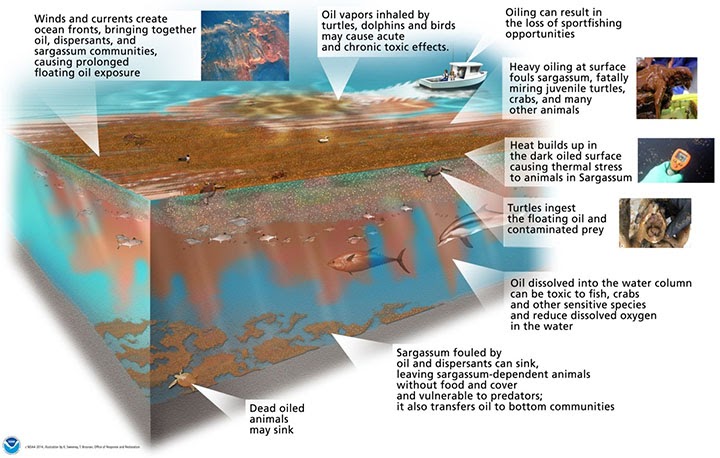Adapted from our 2015 blog, "What Happens When Oil Spills Meet Massive Islands of Seaweed?"
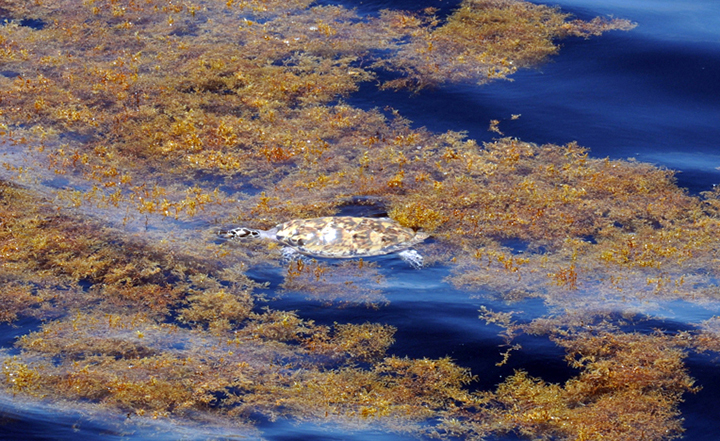
The young loggerhead sea turtle, its ridged shell only a few inches across, perches calmly among a floating island of brown seaweed called sargassum. Suddenly, a shadow passes overhead. A hungry seabird? Taking no chances, the small sea turtle dips beneath the ocean surface. It dives through the sargassum's tangle of branches and bladders filled with air, which keep everything afloat.
Open ocean stretches for miles around the free-floating sargassum mats — which provide critical refuge to juvenile sea turtles in the Gulf of Mexico — as they drift slowly with the currents. Unfortunately, these currents can just as easily push floating oil. This puts sargassum and all the creatures it supports in the path of oil spills.
Home Sweet Sargassum
All sea turtles hatch on sandy beaches, crawl to the waves, and head to the vast open ocean. In the Gulf of Mexico (home to five species of sea turtles) these tiny turtles take refuge in sargassum where they drift, hide from predators, and grow until they are big enough to swim and dive well. Finally, as larger juveniles and adults, they swim to more open waters to feed and grow, until females eventually return to the beach where they were born to lay their own eggs.
Sea turtles aren’t alone in seeking safety and food in these buoyant mazes of seaweed. Sargassum is an important part of the Gulf of Mexico. Some shrimp, crabs, and fish are specially suited to life in sargassum. Certain species of fish and shark spawn there. Each year, humpback whales, tuna, and seabirds migrate across these fruitful waters, taking advantage of the gathering of life that occurs where ocean currents converge.
Deepwater Horizon’s Impacts on Sea Turtles and Sargassum
However, an abundance of marine life isn't the only other thing that can accumulate with these large patches of sargassum. During the Deepwater Horizon oil spill disaster of 2010 oil slicks and sargassum matts were pushed together by ocean currents. Oiled sargassum was found more than 150 miles from the broken well, and heavy oil affected more than 675 square miles in the northern Gulf of Mexico.
As the ocean currents brought the oil into contact with sargassum, oil coated the snarled branches and bladders of the seaweed. Marine life living within and near the oiled sargassum came into contact with the oil as they dove, swam, and rested among the floating mats, and juvenile sea turtles were especially vulnerable.
As air breathers, it starts when they raise their heads above the water's surface to breathe. When sea turtles surface in a slick, they can inhale oil and its vapors into their lungs; gulp oil into their mouths, down their throats, and into their digestive tracts while feeding; and become coated in oil, to the point of becoming entirely mired and unable to swim. As the sun beat down on the oiled ocean's surface, it raised water temperatures to extreme levels for the tiny turtles floating in sargassum. The effects of oiled sargassum during Deepwater Horizon were deadly.
From Pollution to Protection
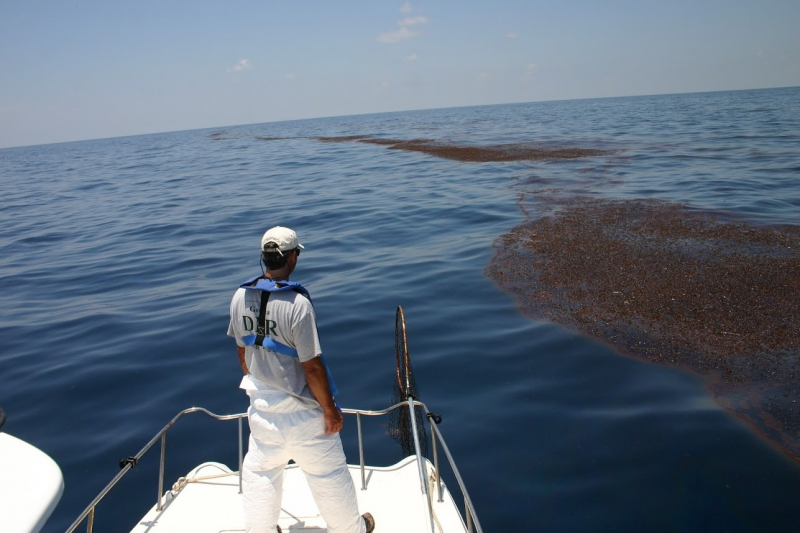
In the decade since the historic Deepwater Horizon, steps have been made toward protecting and restoring sea turtles, sargassum, and other resources injured by the spill. An $8.8 billion settlement was reached with BP in 2016 to fund restoration, and projects benefiting sea turtles are currently underway across the Gulf of Mexico.
NOAA and the U.S. Fish and Wildlife Service have also designated sargassum as a critical habitat for threatened loggerhead sea turtles. Sargassum has also been designated as Essential Fish Habitat by the Gulf of Mexico Fishery Management Council and the National Marine Fisheries Service because it also provides nursery habitat for many important fish species.
Finally, scientists have taken what we’ve learned about responding to sea turtles during spills and are putting it to good use. NOAA published “Guidelines for Oil Spill Response and Natural Resource Damage Assessment: Sea Turtles,” which includes tools and information about sea turtles to help prepare for future oil spills.
Sea Turtle Week is dedicated to the understanding and conservation of these amazing creatures worldwide. Sea turtles have swum the oceans for millennia, and it’s up to all humans to protect them from the threats we’ve created.
Experts at NOAA continue to work diligently with our partners, so when an oil spill disaster strikes again we will be even better prepared to respond on behalf of sea turtles.
